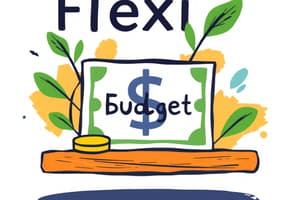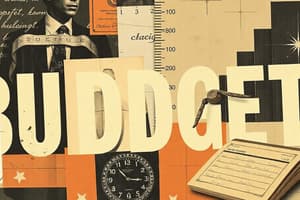Podcast
Questions and Answers
What is the primary purpose of a flexible budget?
What is the primary purpose of a flexible budget?
- To adjust budgeted expenses based on actual sales activity (correct)
- To simplify financial reporting
- To establish fixed spending limits
- To compare actual revenue with projected revenue
What does a flexible budget variance indicate?
What does a flexible budget variance indicate?
- Differences between budgeted expenses and actual expenses (correct)
- Differences between fixed and variable costs
- Differences between budgeted revenues and actual revenues
- Differences between projected profits and actual profits
When actual revenues are included in a flexible budget model, what type of variances can occur?
When actual revenues are included in a flexible budget model, what type of variances can occur?
- Only expenses can vary based on unit sales (correct)
- Only revenues will be compared with standard revenues
- Only revenues can vary based on expenses
- Variances can occur in both revenues and expenses
In a flexible budget, how is the budgeted expense level determined?
In a flexible budget, how is the budgeted expense level determined?
What is a potential implication of a large flexible budget variance?
What is a potential implication of a large flexible budget variance?
If 800 units are sold at a price of $102 per unit when the expected price is $100, what is the favorable revenue variance?
If 800 units are sold at a price of $102 per unit when the expected price is $100, what is the favorable revenue variance?
What results from using a fixed budget model instead of a flexible budget model?
What results from using a fixed budget model instead of a flexible budget model?
If actual cost per unit is $50 instead of a budgeted $45, how is this reflected in the flexible budget variance?
If actual cost per unit is $50 instead of a budgeted $45, how is this reflected in the flexible budget variance?
What does an aggregate unfavorable variance of $2,400 indicate?
What does an aggregate unfavorable variance of $2,400 indicate?
How is a flexible budget different from a fixed budget in terms of revenue?
How is a flexible budget different from a fixed budget in terms of revenue?
Flashcards are hidden until you start studying
Study Notes
Flexible Budget Overview
- A flexible budget adjusts revenue and expenses based on actual sales activity, providing a dynamic financial planning tool.
- Actual revenues or units sold are entered into the flexible budget model, generating budgeted expenses through predetermined formulas linked to sales percentages.
- The flexible budget facilitates comparison against actual results for performance control and management.
Flexible Budget Variance
- A flexible budget variance indicates the difference between the budgeted amounts generated by the model and the actual financial results achieved.
- Variances primarily arise from budgeted versus actual expenses when actual revenues are input; variations in revenue occur when actual units sold are used.
- Larger flexible budget variances may signal the need to revise the underlying formulas for more accurate budgeting in future periods.
Comparative Analysis
- The total flexible budget variance is typically less than the total variance from a fixed budget model, as it adapts to align with actual economic performance.
- This adaptability can enhance management’s ability to analyze performance and control operations more effectively.
Example Scenario
- If a flexible budget anticipates a selling price of $100 per unit and 800 units are sold at an actual price of $102, a favorable revenue variance of $1,600 arises (800 units x $2 favorable price difference).
- Conversely, if the expected cost of goods sold is $45 per unit but the actual cost rises to $50, an unfavorable cost variance of $4,000 occurs (800 units x $5 unfavorable cost difference).
- The cumulative effect results in an unfavorable total variance of $2,400 (- $4,000 + $1,600).
Studying That Suits You
Use AI to generate personalized quizzes and flashcards to suit your learning preferences.




